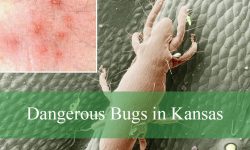Centipedes are some of the most fascinating yet often misunderstood creatures found across Texas. With their elongated bodies, numerous legs, and venomous fangs, these arthropods are efficient predators that help control insect populations. While some species are small and harmless, others, like the Texas Redheaded Centipede, can grow impressively large and deliver a painful bite. Understanding the centipede species in Texas can help residents and outdoor enthusiasts identify these creatures and learn about their role in the ecosystem.
Texas is home to a variety of centipede species, each with unique physical traits and habitat preferences. From the Giant Desert Centipede, which thrives in arid regions, to the House Centipede, commonly found indoors, these creatures have adapted to different environments. While most Texas centipedes are not dangerous to humans, their bites can cause discomfort, making it important to recognize and respect their presence in nature.
In this article, we will explore the six most common centipede species in Texas, highlighting their characteristics, habitats, and behaviors. Whether you’re a nature enthusiast, a homeowner concerned about centipedes indoors, or simply curious about these remarkable arthropods, this guide will provide valuable insights. Read on to discover the most frequently encountered Texas centipede species and learn how to identify them with ease!
Different Types of Centipedes in Texas
Texas Redheaded Centipede (Scolopendra heros)

The Texas Redheaded Centipede is the largest centipede species found in Texas, with an average length of 6 to 8 inches, though some individuals can grow even larger. This species is known for its intimidating appearance and striking coloration, making it one of the most recognizable centipedes in North America. It has a bright red head, a dark blue or black body, and vibrant yellow or orange legs, creating a highly contrasting color scheme that serves as a warning to predators. Despite its fearsome look, it is not deadly to humans, but its bite can cause intense pain, swelling, and localized skin irritation.
This species is a formidable predator that primarily feeds on insects, spiders, small lizards, and even rodents. It uses its powerful venom to immobilize prey before consuming it. Equipped with long, venomous forcipules (fang-like appendages), the Texas Redheaded Centipede can deliver a painful sting if provoked. Though not lethal to humans, the venom contains neurotoxins that can cause severe discomfort. People who are allergic to insect stings may experience stronger reactions, but serious complications are rare.
The Texas Redheaded Centipede thrives in arid and semi-arid environments, preferring rocky, dry terrains and wooded areas. It is commonly found hiding under rocks, logs, and leaf litter during the day, coming out at night to hunt. This species is known to be highly defensive and will raise its body in an aggressive posture if threatened. While its striking appearance may be alarming, it plays an essential role in the ecosystem by keeping pest populations in check.
Giant Desert Centipede (Scolopendra polymorpha)
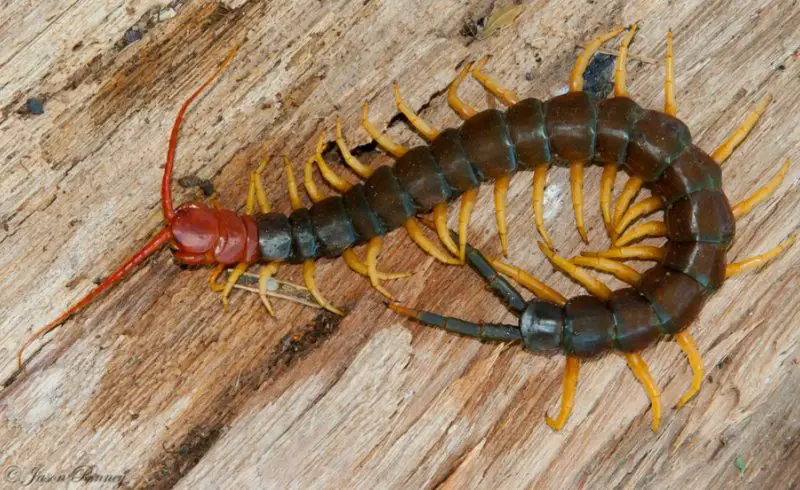
The Giant Desert Centipede, also known as the Sonoran Desert Centipede or Tiger Centipede, is one of the most commonly encountered centipedes in Texas. It grows between 6 and 7 inches long, making it slightly smaller than the Texas Redheaded Centipede but still quite large compared to other centipede species. This centipede is well adapted to dry, arid environments and is capable of surviving extreme temperatures with limited access to water.
Its body exhibits a range of colors, including brown, tan, and reddish-orange, often featuring alternating dark and light bands along its segments. The legs are yellowish or light orange, and its head is typically darker than the rest of its body. This species relies on speed and venom to subdue its prey, which includes insects, small amphibians, and occasionally small mammals. Its venom contains enzymes that break down tissue, allowing it to consume prey more efficiently.
The Giant Desert Centipede is primarily found in deserts, scrublands, and rocky terrains. It seeks shelter under stones, logs, and inside crevices during the day to avoid the harsh sun, becoming active at night when temperatures are cooler. While its bite can be painful, it is not life-threatening to humans, causing symptoms such as localized pain, redness, and swelling. However, as with other venomous arthropods, individuals with allergies should be cautious when encountering this species.
Eastern Bark Centipede (Hemiscolopendra marginata)
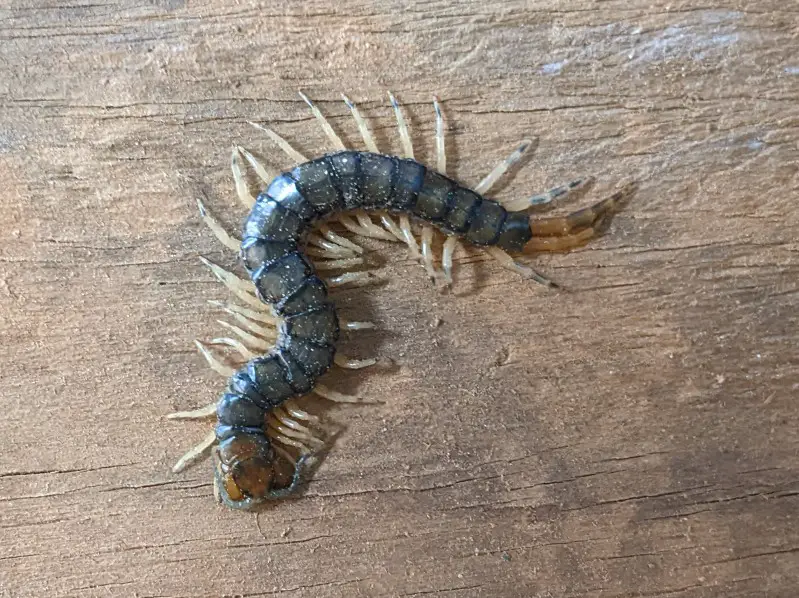
The Eastern Bark Centipede is a medium-sized species, typically reaching around 4 inches in length. While it is not as large or aggressive as some of the Scolopendra species, it is still a highly capable predator that plays a significant role in controlling insect populations.
This centipede has a light brown or tan body with darker longitudinal stripes running along its back. Its legs are lighter in color, and its relatively small size allows it to move quickly through narrow spaces. Unlike larger centipedes, the Eastern Bark Centipede’s venom is relatively mild and not considered medically significant to humans. However, its bite can still cause irritation, minor swelling, and pain similar to a bee sting.
As its name suggests, the Eastern Bark Centipede is commonly found in wooded areas, often hiding under tree bark, fallen logs, and leaf litter. It prefers moist, shaded environments and is most active during humid conditions. Unlike some of the larger centipedes, it is less likely to bite unless provoked or handled directly. This species is beneficial to ecosystems, as it helps control populations of insects and other small arthropods.
Green-striped Centipede (Scolopocryptops sexspinosus)
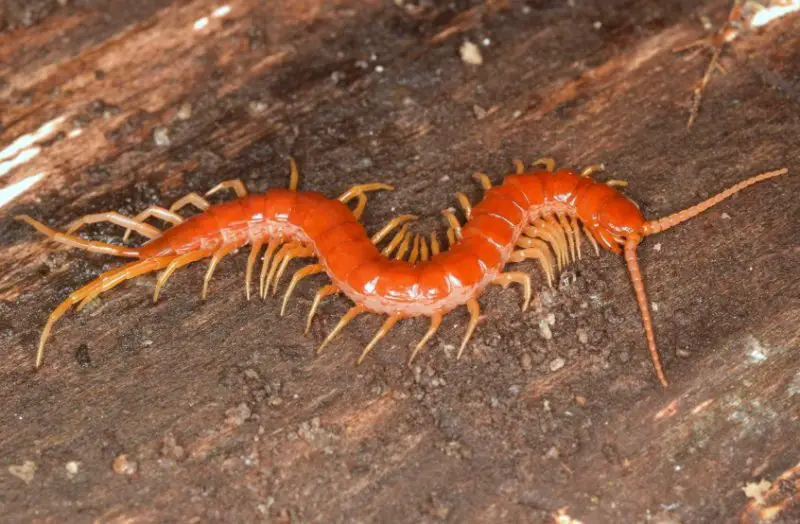
The Green-striped Centipede is a smaller species, usually measuring between 2 and 4 inches in length. Despite its modest size, it is an efficient and agile predator, feeding on insects, spiders, and other small invertebrates. Its body structure allows it to navigate through tight spaces, making it well-adapted to forested environments.
This centipede has a reddish-brown body with faint greenish stripes along its back, which provide subtle camouflage in leaf litter and damp soil. Unlike some of the larger Scolopendra species, the Green-striped Centipede does not have as strong a venom, and its bite is usually no more painful than a mild insect sting. However, like most centipedes, it will defend itself if threatened.
This species prefers humid and forested areas, often found beneath logs, rocks, and within decomposing plant matter. It is highly active and relies on its speed to capture prey and escape potential threats. Though not aggressive toward humans, it will bite if handled roughly. Due to its small size, it is often overlooked, but it plays a crucial role in natural pest control.
House Centipede (Scutigera coleoptrata)
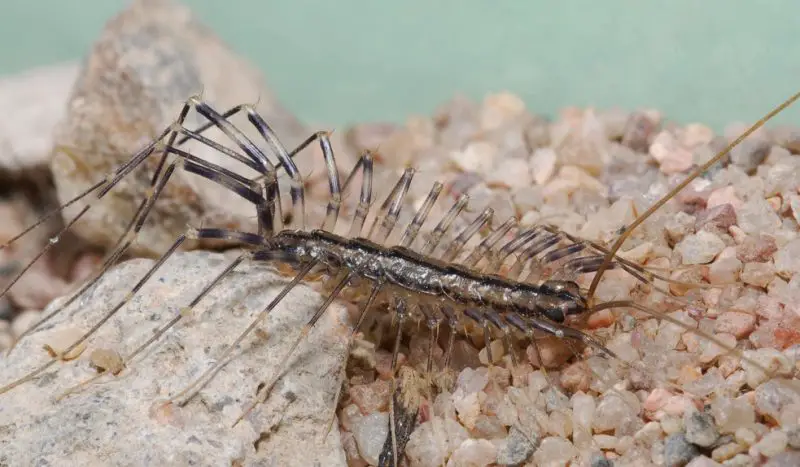
The House Centipede is one of the most frequently encountered centipedes in Texas, often found inside homes, garages, and basements. Unlike other centipede species, it has a uniquely long and slender body, allowing it to move with remarkable speed.
Its body is grayish-yellow with dark stripes running along its back. It has up to 15 pairs of long, delicate legs that extend far beyond its body, giving it a distinctive and somewhat eerie appearance. Despite its intimidating look, the House Centipede is actually beneficial, as it preys on common household pests such as cockroaches, silverfish, and spiders.
House centipedes prefer damp and dark environments, such as basements, bathrooms, and crawl spaces. Unlike other centipedes that rely on brute force to subdue prey, this species uses its long legs to “lasso” and trap insects before delivering a venomous bite. While its venom is not harmful to humans, its bite may cause mild irritation. Most people prefer to leave House Centipedes alone since they help control indoor pest populations.
Florida Blue Centipede (Hemiscolopendra chilensis)
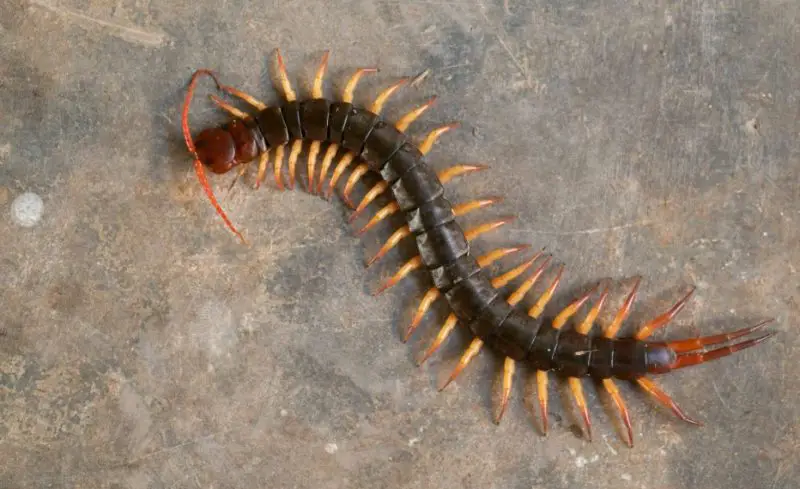
The Florida Blue Centipede is a relatively small species, growing between 2 and 3 inches in length. It is not as well-known as some of the larger centipede species in Texas, but it is still an important predator in its habitat.
Its body is bluish-gray, with lighter-colored legs that contrast against its darker head. This unique coloration helps it blend into moist environments, making it less noticeable to predators. Though it has venomous fangs, its venom is mild and does not pose a significant threat to humans, causing only minor pain and swelling if bitten.
This centipede thrives in humid, forested areas, often found hiding under rocks, logs, and damp leaf litter. It is most active at night when it hunts for small insects and other invertebrates. While it is not aggressive, it will defend itself if disturbed. Its small size and secretive nature make it less commonly seen than other centipedes in Texas.


